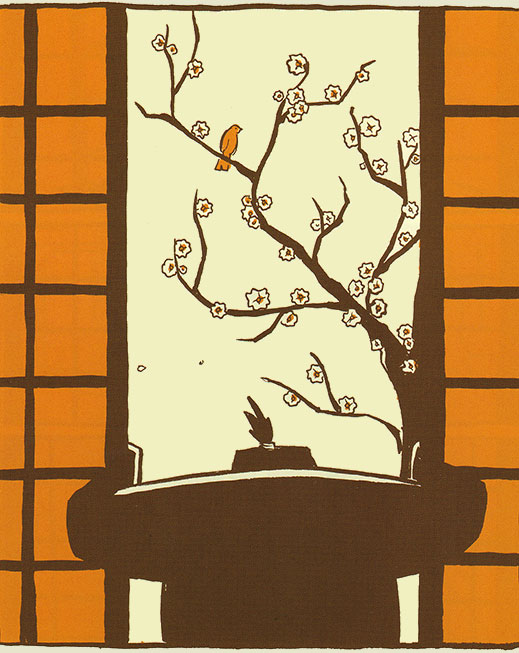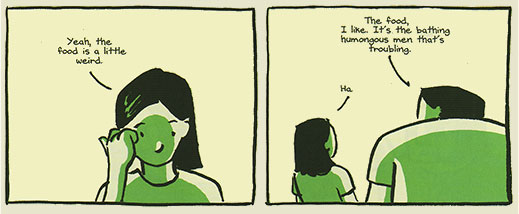Sumo

It's funny. I wouldn't have noticed had seemingly arbitrary circumstances not come together as well as they did. Call it fate. Call it serendipity. Call it my doom. Or destiny or predestination or blind harmless luck. Or even all of the the above. The close of the matter is that when reading Thien Pham's Sumo tonight, I saw things that I entirely missed when I read Thien Pham's Sumo two weeks ago—and this due entirely to a change in frame of mind developed by forces exterior to Pham's book or my reading of it. Colour me appreciative.
Over the last couple days, I'd been reading a text on the complex literary structures of the Hebrew scriptures. The day before that, a friend mentioned the works of David Mitchell, which brought to mind his wonderful and lauded Cloud Atlas, a novel distinct in its work-length chiastic structure. And the week before that, I had been thinking of David Foster Wallace's The Pale King and how often in contemporary literature (modernist and postmodernist) authors experiment and play with structures outside the straightforward linear narrative. With the consideration of these devices occupying so much of my thought-life this last week, approaching Sumo again revealed immediately a sense of Pham's intentional governance of his story and its order of revelation.

At its most basic and pared-down, Pham has written a graphic novella whose content is perhaps enough only to fill out a short story. Scott is a former American football hopeful who, in the wake of losing that dream and the girlfriend who came pre-packaged with it, is attempting to rebuild his life as a sumo wrestler in Japan. Pham isn't interested in Scott's whole story but instead approaches him in the first (and therefore most important) of many do-or-die moments in his career: just as he prepares for his final try to make the transition from rikishi to sekitori (that is, from lower division to upper). Sumo's entire present tense may only occur over the space of a couple days, but it's clear that Pham is putting forth a representative pericope of a whole life lived. What occurs in Sumo's narrative span is Scott's day of judgment—on this story will hinge our evaluation of Scott as a whole person. This is his past, present, future—weighed on the scales of the readers' subjective evaluation.

I was initially put off by how little time Pham allows us to spend with his characters—characters he ably turns into people whose lives I want to inhabit. I wanted to linger and see the result of their efforts, to see them overcome adversity or be ruined by it. I liked Scott and the coach and Asami, the girl. Their lives and dreams and future became important to me, but Pham robbed me of any of that because this wasn't the story he was telling. There was, perhaps, a bigger fish at stake—and it's through his literary structure that his intent finds its culmination.

Pham presents his story in a patterned series of segments that alternate between the present and two themed flashbacks, one in America and the other in Japan. The present-day narrative is coloured in orange, the American flashback in periwinkle, and the Japanese flashback in green. The way Pham alternates between eras in Scott's life gives the most time to the present and splits evenly between his two pasts. Here's a visual diagram of the pattern:

And beyond just his conscious staggering of narrative streams, Pham uses a technique whereby the length of each segment telescopes in ever-diminishing increments so that, finally, Pham is spending only a single panel in any given story period. Here's a small-scale representation of how Sumo's narrative is laid out in terms of page-length:

Generally, Pham uses episodes from Scott's past to inform our immediate reading of the wrestler's present; but from the above you can see that he ends the book in a longer segment from Scott's past in Japan. It's a surprising conclusion, but effective: using a moment from Scott's past not only to guide our reading of Scott's present but of Pham's book as a whole.
What seemed an adequate conclusion in my first reading took on new light in second approach. Happenstance in the form of a sudden confluence of my interests in literary structure helped give me better appreciation for a carefully wrought story.

Additional Notes
- Pham also uses his page-numbering conceit in thematic ways as well. Page numbers in orange sections are decorated by a tiny representation of the dohyo, the sumo wrestlers' ring. Numbers in the blue section are placed inside a water tower, representative of Scott's hometown in America. Finally, the green sections are numbered within a green fish, a symbol which is explored over the course of several of the Japanese flashbacks.
- Sumo's cover is interesting, showing on its front an idealized Scott, successfully parting the seas in full mastery of his sumo strength and wearing his kesho-mawashi, a ceremonial silk apron—something we never see within the scope of the book, as lower-division wrestlers aren't permitted the luxury of spectacle. On the rear of the cover, we see a pre-sumo and blond Scott—alone and engulfed in water up to his neck. Pham's book, of course, is the question that sits between these two extremes: which will Scott become and what will define him, the disappointments of the past or the impossible glories of the future?

Good Ok Bad features reviews of comics, graphic novels, manga, et cetera using a rare and auspicious three-star rating system. Point systems are notoriously fiddly, so here it's been pared down to three simple possibilities:
3 Stars = Good
2 Stars = Ok
1 Star = Bad
I am Seth T. Hahne and these are my reviews.
Browse Reviews By
Other Features
- Best Books of the Year:
- Top 50 of 2024
- Top 50 of 2023
- Top 100 of 2020-22
- Top 75 of 2019
- Top 50 of 2018
- Top 75 of 2017
- Top 75 of 2016
- Top 75 of 2015
- Top 75 of 2014
- Top 35 of 2013
- Top 25 of 2012
- Top 10 of 2011
- Popular Sections:
- All-Time Top 500
- All the Boardgames I've Played
- All the Anime Series I've Seen
- All the Animated Films I've Seen
- Top 75 by Female Creators
- Kids Recommendations
- What I Read: A Reading Log
- Other Features:
- Bookclub Study Guides










